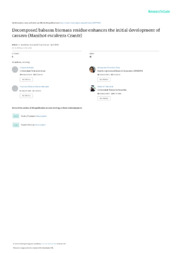Decomposed babassu biomass residue enhances the initial development of cassava (Manihot esculenta Crantz).
Decomposed babassu biomass residue enhances the initial development of cassava (Manihot esculenta Crantz).
Author(s): ANDRADE, H. A. F. de; SILVA-MATOS, R. R. S. da; MACHADO, N. A. F.; OLIVEIRA, A. R. F.; GARRETO, V. C.; LEITE, M. R. L.; PONTES, S. F.; SILVA, A. F.; MACHADO, F. G. A.; LOPES, P. R. C.
Summary: Cassava is a tuber of significant cultural and economic importance for family farming. However, cultivation in the northeastern region of Brazil is characterized by low productivity, resulting from cultivation in naturally marginal soil, which can cause food insecurity to farmers in the region. The objective was to evaluate the initial development of cassava using substrates derived from decomposed residue from babassu biomass, as a supplement to the soils with low natural fertility. The experiment was carried out in a greenhouse in the municipality of Chapadinha, state of Maranhão, Brazil. The treatments consisted of six inclusion levels of babassu biomass (BB) in the substrates: S0, 100% soil; S20, 20% BB + 80% soil; S40, 40% BB + 60% soil; S60, 60% BB + 40% soil; S80, 80% BB + 20% soil; and S100, 100% BB. The treatments were arranged in a completely randomized design, with four replications. The soil used in the experiment is classified as dystrophic Yellow Oxisol. At the end of the experiment, the following were evaluated: percentage of cuttings survival, leaf area, shoot length, shoot diameter, root length, root volume, aerial part dry mass and root dry mass. With the exception of the sprout diameter, the inclusion of BB in the substrates provided a significant positive effect for all analyzed variables, which demonstrates the early response capacity of cassava seedlings to the use of organic waste associated with the soil low fertility. The use of babassu biomass as an organic fertilizer improves soil fertility, stimulating the growth and development of cassava seedlings in a sustainable production system.
Publication year: 2021
Types of publication: Journal article
Unit: Embrapa Semi-arid Region
Observation
Some of Embrapa's publications are published as ePub files. To read them, use or download one of the following free software options to your computer or mobile device. Android: Google Play Books; IOS: iBooks; Windows and Linux: Calibre.
Access other publications
Access the Agricultural Research Database (BDPA) to consult Embrapa's full library collection and records.
Visit Embrapa Bookstore to purchase books and other publications sold by Embrapa.

